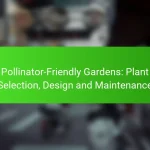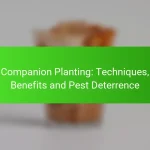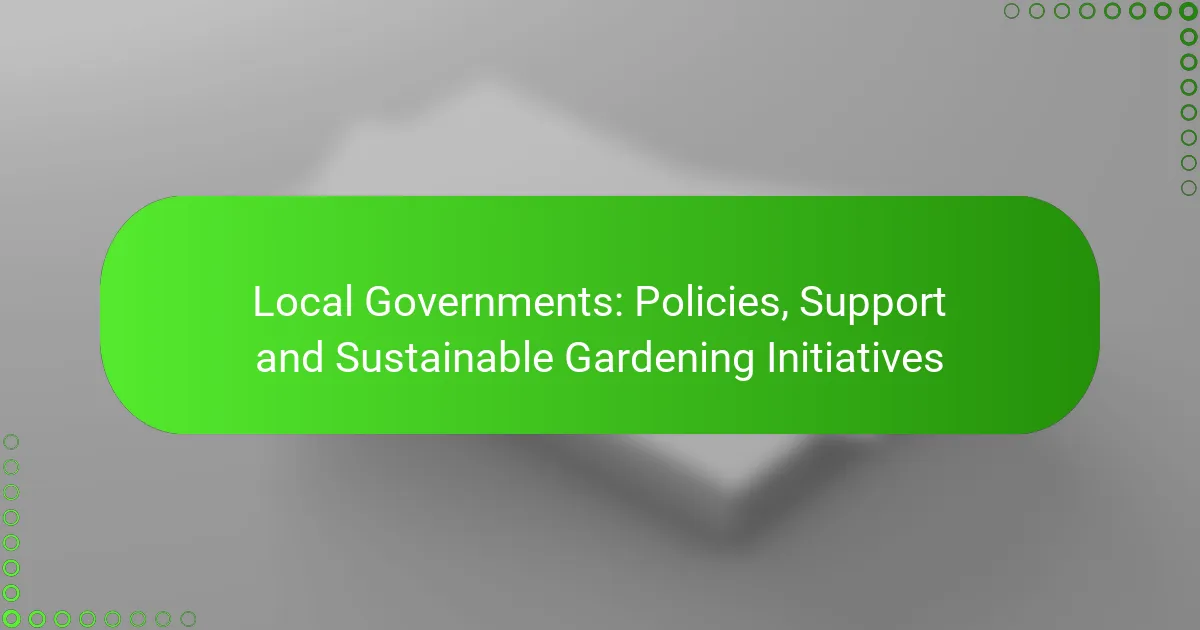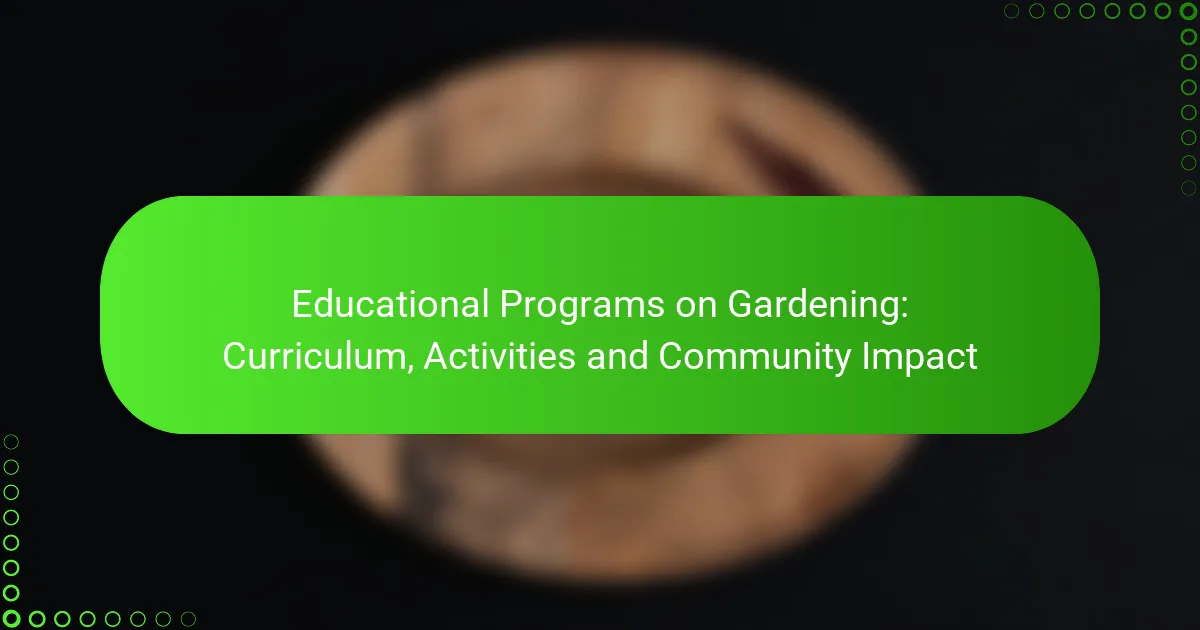Local governments play a crucial role in promoting sustainable gardening through policies that emphasize water conservation, community involvement, and organic practices. By providing resources and financial support, they empower residents to adopt eco-friendly gardening methods that enhance environmental sustainability and food security. These initiatives not only improve community resilience but also contribute to local biodiversity and overall well-being.
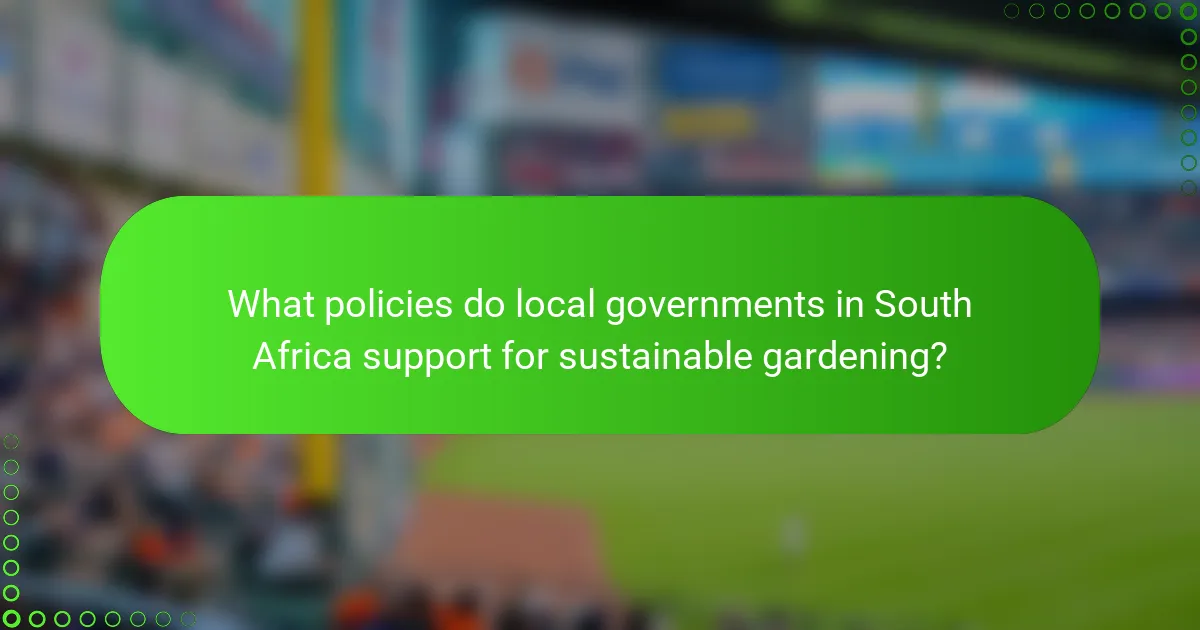
What policies do local governments in South Africa support for sustainable gardening?
Local governments in South Africa implement various policies to promote sustainable gardening, focusing on water conservation, community engagement, urban greening, and organic practices. These initiatives aim to enhance environmental sustainability, improve food security, and foster community resilience.
Water conservation regulations
Water conservation regulations in South Africa are critical for sustainable gardening, especially in regions prone to drought. Local governments often enforce restrictions on water usage, encouraging practices such as rainwater harvesting and the use of drought-resistant plants. Gardeners are advised to implement drip irrigation systems to minimize water waste and comply with local guidelines.
Additionally, municipalities may provide resources and workshops on efficient watering techniques, helping residents understand the importance of conserving this vital resource. Engaging with local authorities can also provide access to incentives for adopting water-saving technologies.
Community gardening initiatives
Community gardening initiatives are supported by local governments to promote food security and community cohesion. These programs often provide land access, resources, and training for residents interested in growing their own food. Participating in community gardens allows individuals to share knowledge, skills, and produce, fostering a sense of belonging.
Local governments may also organize events and workshops to educate participants on sustainable gardening practices, such as composting and organic pest control. Collaboration with local NGOs can enhance these initiatives, providing additional support and resources for community members.
Urban greening policies
Urban greening policies aim to enhance green spaces within cities, which benefits both the environment and residents’ quality of life. Local governments often promote tree planting, the establishment of parks, and the creation of green roofs to improve air quality and reduce urban heat. These policies encourage residents to participate in greening efforts through volunteer programs.
Additionally, municipalities may offer grants or subsidies for urban gardening projects, helping to transform underutilized spaces into vibrant green areas. Engaging with local environmental groups can provide further opportunities for collaboration and support in urban greening efforts.
Incentives for organic practices
Incentives for organic practices are increasingly being adopted by local governments to promote sustainable gardening. These may include financial support, such as grants or tax rebates, for gardeners who use organic methods and materials. Local authorities often provide educational resources to help residents transition to organic gardening techniques.
Community workshops and training sessions can further facilitate the adoption of organic practices, covering topics like soil health, pest management, and crop rotation. By participating in these programs, gardeners can not only improve their own practices but also contribute to a healthier local ecosystem.
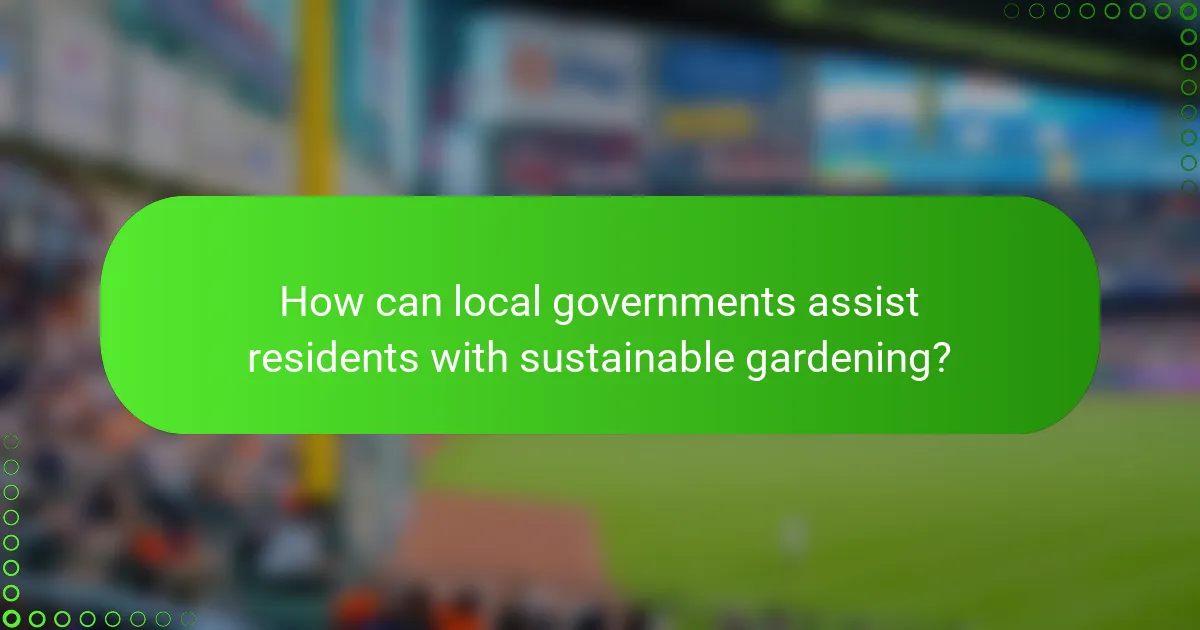
How can local governments assist residents with sustainable gardening?
Local governments can play a vital role in promoting sustainable gardening by providing resources, financial support, and access to native plants. These initiatives help residents adopt eco-friendly practices that benefit both their gardens and the environment.
Providing educational resources
Local governments can offer workshops, online courses, and informational pamphlets to educate residents about sustainable gardening techniques. Topics may include composting, water conservation, and organic pest management.
Additionally, municipalities can partner with local gardening clubs or environmental organizations to host community events. These gatherings can foster knowledge sharing and encourage residents to implement sustainable practices in their own gardens.
Offering grants for gardening projects
Many local governments provide grants to support community gardening initiatives, allowing residents to fund projects that promote sustainability. These grants can cover costs for materials, tools, and even educational programs.
Residents interested in applying for these grants should check their local government’s website for specific eligibility criteria and application deadlines. Typically, grant amounts can range from a few hundred to several thousand dollars, depending on the project’s scope.
Facilitating access to native plants
Local governments can enhance sustainable gardening by facilitating access to native plants, which are better adapted to the local environment and require less maintenance. This can be achieved through plant sales, community nurseries, or partnerships with local horticultural societies.
Residents should look for programs that offer native plant giveaways or discounts at local nurseries. Incorporating native species into gardens can improve biodiversity and attract beneficial wildlife, such as pollinators.
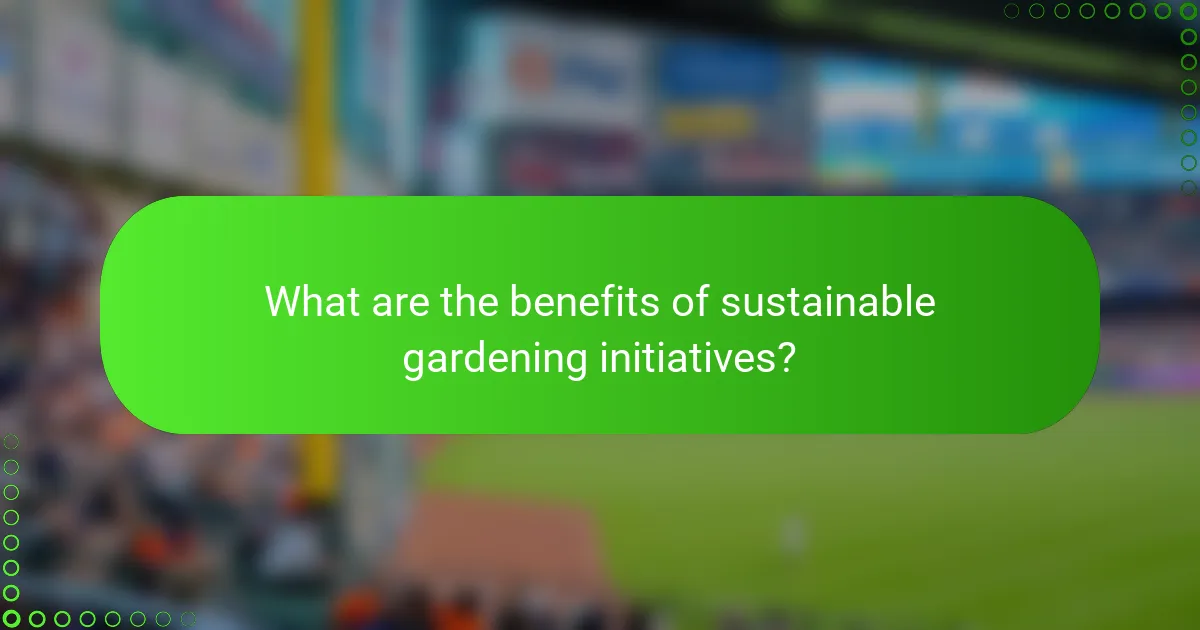
What are the benefits of sustainable gardening initiatives?
Sustainable gardening initiatives offer numerous benefits, including environmental health, community well-being, and economic savings. These practices promote ecological balance while fostering a sense of community and enhancing local biodiversity.
Improved biodiversity
Sustainable gardening enhances biodiversity by creating habitats for various species, including pollinators like bees and butterflies. By incorporating native plants and reducing chemical use, gardeners can support local ecosystems and increase the variety of flora and fauna in their area.
To maximize biodiversity, consider planting a mix of perennials, annuals, and shrubs that are native to your region. This approach not only attracts wildlife but also promotes resilience against pests and diseases.
Reduction of carbon footprint
Implementing sustainable gardening practices can significantly reduce your carbon footprint. Techniques such as composting, using organic fertilizers, and minimizing lawn areas contribute to lower greenhouse gas emissions and improved soil health.
For example, replacing traditional lawns with drought-resistant plants can decrease water usage and reduce the need for gas-powered lawn equipment. Additionally, utilizing rain barrels for irrigation can further minimize environmental impact.
Enhanced community engagement
Sustainable gardening initiatives foster community engagement by bringing people together to share knowledge, resources, and experiences. Community gardens and workshops encourage collaboration and strengthen social ties among residents.
Participating in local gardening groups or initiatives can provide opportunities for education and skill-building. Consider organizing events like plant swaps or educational sessions to promote sustainable practices and connect with neighbors.

What are the challenges faced by local governments in implementing these initiatives?
Local governments encounter several significant challenges when implementing sustainable gardening initiatives, including financial constraints, lack of public engagement, and regulatory obstacles. Addressing these issues is crucial for the successful promotion of environmentally friendly practices within communities.
Lack of funding
One of the primary challenges is the lack of adequate funding for sustainable gardening programs. Local governments often operate on tight budgets, which can limit their ability to invest in new initiatives. Grants and partnerships with non-profits can provide some financial relief, but these resources are not always guaranteed.
To mitigate funding issues, local governments can prioritize initiatives that require minimal investment, such as community gardens or educational workshops. Seeking sponsorships from local businesses can also help supplement costs.
Insufficient public awareness
Many residents may not be aware of the benefits of sustainable gardening or the initiatives available to them. This lack of awareness can lead to low participation rates and minimal community impact. Effective communication strategies are necessary to inform the public about the importance of these programs.
Local governments can utilize social media, community events, and workshops to raise awareness. Collaborating with schools and local organizations can also enhance outreach efforts and engage a broader audience.
Regulatory hurdles
Regulatory hurdles can impede the implementation of sustainable gardening initiatives. Zoning laws, land use regulations, and restrictions on water usage can create barriers for community gardens and other projects. Navigating these regulations requires careful planning and coordination with various government departments.
To overcome these challenges, local governments should review existing regulations and identify areas for improvement. Engaging with community stakeholders during the planning process can also help ensure that initiatives align with local needs and comply with regulations.

How do local governments measure the success of gardening initiatives?
Local governments measure the success of gardening initiatives through various metrics that reflect community engagement, environmental benefits, and resident satisfaction. These measurements help assess the overall impact and effectiveness of the programs in promoting sustainable gardening practices.
Community participation rates
Community participation rates are a key indicator of the success of gardening initiatives. Local governments often track the number of volunteers, event attendance, and the diversity of participants involved in gardening programs. High participation rates suggest strong community interest and support for sustainable gardening efforts.
To effectively measure participation, governments may conduct surveys or maintain records of events and volunteer hours. Aiming for participation rates of at least 30-50% of the local population can indicate a successful initiative.
Environmental impact assessments
Environmental impact assessments evaluate the ecological benefits of gardening initiatives, such as improved biodiversity, soil health, and water conservation. Local governments may utilize tools like soil testing and biodiversity surveys to gather data on these aspects.
Assessments can also include monitoring changes in local wildlife populations or reductions in stormwater runoff. Setting clear environmental goals, such as increasing native plant species by a certain percentage, can help gauge the effectiveness of these initiatives.
Feedback from residents
Feedback from residents provides valuable insights into the perceived success of gardening initiatives. Local governments often collect this information through surveys, community meetings, or online platforms where residents can share their experiences and suggestions.
Analyzing feedback helps identify strengths and areas for improvement in gardening programs. Encouraging open communication and regularly reviewing resident input can lead to more effective and responsive initiatives, fostering a sense of community ownership and satisfaction.

What role do partnerships play in sustainable gardening?
Partnerships are crucial in sustainable gardening as they foster collaboration between local governments, community organizations, and residents. These alliances enhance resource sharing, knowledge exchange, and support for sustainable practices, leading to more effective gardening initiatives.
Collaboration with local governments
Local governments play a pivotal role in sustainable gardening by providing resources, funding, and policy support. Collaborating with these entities can help community gardens access grants or subsidies, making it easier to implement eco-friendly practices. Engaging with local authorities also ensures compliance with regulations and promotes community involvement.
Engagement with community organizations
Community organizations often have established networks and expertise that can benefit sustainable gardening initiatives. By partnering with these groups, gardens can tap into educational programs, volunteer support, and outreach efforts. This collaboration can lead to increased participation and awareness of sustainable gardening practices among residents.
Building relationships with local businesses
Local businesses can contribute to sustainable gardening by providing materials, sponsorships, or expertise. Establishing partnerships with nurseries, hardware stores, or landscaping companies can lead to discounts on supplies or donations of plants. These relationships not only support gardens financially but also strengthen community ties.
Creating networks among gardeners
Forming networks among gardeners encourages knowledge sharing and resource pooling. Gardeners can exchange seeds, tools, and best practices, fostering a sense of community and collaboration. This collective effort can enhance the sustainability of gardening projects and promote resilience against challenges like pests or climate change.



